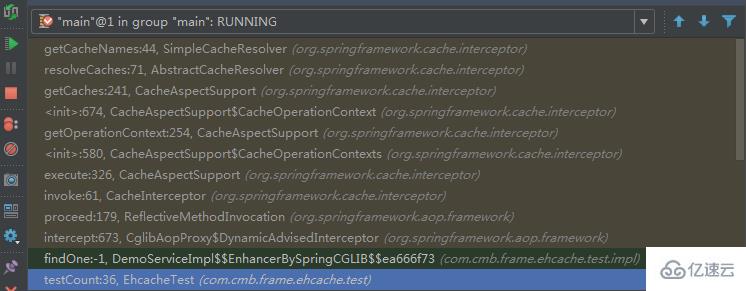小编给大家分享一下Spring Boot缓存源码是什么,相信大部分人都还不怎么了解,因此分享这篇文章给大家参考一下,希望大家阅读完这篇文章后大有收获,下面让我们一起去了解一下吧!
项目里面要增加一个应用缓存,原本想着要怎么怎么来整合ehcache和springboot,做好准备配置这个配置那个,结果只需要做三件事:
pom依赖
写好一个ehcache的配置文件
在boot的application上加上注解@EnableCaching.
这就完事了,是不是很魔幻。
pom依赖
<dependency>
<groupId>net.sf.ehcache</groupId>
<artifactId>ehcache</artifactId>
<version>2.10.5</version>
</dependency>配置文件
<?xml version="1.0" encoding="UTF-8"?>
<ehcache>
<!-- 设定缓存的默认数据过期策略 -->
<defaultCache
maxElementsInMemory="500"
maxElementsOnDisk="2000"
eternal="false"
overflowToDisk="true"
timeToIdleSeconds="90"
timeToLiveSeconds="300"
diskPersistent="false"
diskExpiryThreadIntervalSeconds="300"/>
</ehcache>应用上加上EnableCaching注解
@SpringBootApplication
@EnableCaching
public class EhCacheApplication {
public static void main(String[] args) {
SpringApplication.run(EhCacheApplication.class, args);
}
}然后就可以在代码里面使用cache注解了,像这样。
@CachePut(value = "fish-ehcache", key = "#person.id")
public Person save(Person person) {
System.out.println("为id、key为:" + person.getId() + "数据做了缓存");
return person;
}
@CacheEvict(value = "fish-ehcache")
public void remove(Long id) {
System.out.println("删除了id、key为" + id + "的数据缓存");
}
@Cacheable(value = "fish-ehcache", key = "#person.id")
public Person findOne(Person person) {
findCount.incrementAndGet();
System.out.println("为id、key为:" + person.getId() + "数据做了缓存");
return person;
}很方便对不对。下面,我们就来挖一挖,看看spring是怎么来做到的。主要分成两部分,一是启动的时候做了什么,二是运行的时候做了什么,三是和第三方缓存组件的适配
启动的时候做了什么、
这个得从@EnableCaching标签开始,在使用缓存功能时,在springboot的Application启动类上需要添加注解@EnableCaching,这个标签引入了
@Target({ElementType.TYPE})
@Retention(RetentionPolicy.RUNTIME)
@Documented
@Import({CachingConfigurationSelector.class})
public @interface EnableCaching {
boolean proxyTargetClass() default false;
AdviceMode mode() default AdviceMode.PROXY;
int order() default 2147483647;
}引入了CachingConfigurationSelector类,这个类便开启了缓存功能的配置。这个类添加了AutoProxyRegistrar.java,ProxyCachingConfiguration.java两个类。
AutoProxyRegistrar : 实现了ImportBeanDefinitionRegistrar接口。这里看不懂,还需要继续学习。
ProxyCachingConfiguration : 是一个配置类,生成了BeanFactoryCacheOperationSourceAdvisor,CacheOperationSource,和CacheInterceptor这三个bean。
CacheOperationSource封装了cache方法签名注解的解析工作,形成CacheOperation的集合。CacheInterceptor使用该集合过滤执行缓存处理。解析缓存注解的类是SpringCacheAnnotationParser,其主要方法如下
/**
由CacheOperationSourcePointcut作为注解切面,会解析
SpringCacheAnnotationParser.java
扫描方法签名,解析被缓存注解修饰的方法,将生成一个CacheOperation的子类并将其保存到一个数组中去
**/
protected Collection<CacheOperation> parseCacheAnnotations(SpringCacheAnnotationParser.DefaultCacheConfig cachingConfig, AnnotatedElement ae) {
Collection<CacheOperation> ops = null;
//找@cacheable注解方法
Collection<Cacheable> cacheables = AnnotatedElementUtils.getAllMergedAnnotations(ae, Cacheable.class);
if (!cacheables.isEmpty()) {
ops = this.lazyInit(ops);
Iterator var5 = cacheables.iterator();
while(var5.hasNext()) {
Cacheable cacheable = (Cacheable)var5.next();
ops.add(this.parseCacheableAnnotation(ae, cachingConfig, cacheable));
}
}
//找@cacheEvict注解的方法
Collection<CacheEvict> evicts = AnnotatedElementUtils.getAllMergedAnnotations(ae, CacheEvict.class);
if (!evicts.isEmpty()) {
ops = this.lazyInit(ops);
Iterator var12 = evicts.iterator();
while(var12.hasNext()) {
CacheEvict evict = (CacheEvict)var12.next();
ops.add(this.parseEvictAnnotation(ae, cachingConfig, evict));
}
}
//找@cachePut注解的方法
Collection<CachePut> puts = AnnotatedElementUtils.getAllMergedAnnotations(ae, CachePut.class);
if (!puts.isEmpty()) {
ops = this.lazyInit(ops);
Iterator var14 = puts.iterator();
while(var14.hasNext()) {
CachePut put = (CachePut)var14.next();
ops.add(this.parsePutAnnotation(ae, cachingConfig, put));
}
}
Collection<Caching> cachings = AnnotatedElementUtils.getAllMergedAnnotations(ae, Caching.class);
if (!cachings.isEmpty()) {
ops = this.lazyInit(ops);
Iterator var16 = cachings.iterator();
while(var16.hasNext()) {
Caching caching = (Caching)var16.next();
Collection<CacheOperation> cachingOps = this.parseCachingAnnotation(ae, cachingConfig, caching);
if (cachingOps != null) {
ops.addAll(cachingOps);
}
}
}
return ops;
}解析Cachable,Caching,CachePut,CachEevict 这四个注解对应的方法都保存到了Collection<CacheOperation> 集合中。
执行方法时做了什么
执行的时候,主要使用了CacheInterceptor类。
public class CacheInterceptor extends CacheAspectSupport implements MethodInterceptor, Serializable {
public CacheInterceptor() {
}
public Object invoke(final MethodInvocation invocation) throws Throwable {
Method method = invocation.getMethod();
CacheOperationInvoker aopAllianceInvoker = new CacheOperationInvoker() {
public Object invoke() {
try {
return invocation.proceed();
} catch (Throwable var2) {
throw new ThrowableWrapper(var2);
}
}
};
try {
return this.execute(aopAllianceInvoker, invocation.getThis(), method, invocation.getArguments());
} catch (ThrowableWrapper var5) {
throw var5.getOriginal();
}
}
}这个拦截器继承了CacheAspectSupport类和MethodInterceptor接口。其中CacheAspectSupport封装了主要的逻辑。比如下面这段。
/**
CacheAspectSupport.java
执行@CachaEvict @CachePut @Cacheable的主要逻辑代码
**/
private Object execute(final CacheOperationInvoker invoker, Method method, CacheAspectSupport.CacheOperationContexts contexts) {
if (contexts.isSynchronized()) {
CacheAspectSupport.CacheOperationContext context = (CacheAspectSupport.CacheOperationContext)contexts.get(CacheableOperation.class).iterator().next();
if (this.isConditionPassing(context, CacheOperationExpressionEvaluator.NO_RESULT)) {
Object key = this.generateKey(context, CacheOperationExpressionEvaluator.NO_RESULT);
Cache cache = (Cache)context.getCaches().iterator().next();
try {
return this.wrapCacheValue(method, cache.get(key, new Callable<Object>() {
public Object call() throws Exception {
return CacheAspectSupport.this.unwrapReturnValue(CacheAspectSupport.this.invokeOperation(invoker));
}
}));
} catch (ValueRetrievalException var10) {
throw (ThrowableWrapper)var10.getCause();
}
} else {
return this.invokeOperation(invoker);
}
} else {
/**
执行@CacheEvict的逻辑,这里是当beforeInvocation为true时清缓存
**/
this.processCacheEvicts(contexts.get(CacheEvictOperation.class), true, CacheOperationExpressionEvaluator.NO_RESULT);
//获取命中的缓存对象
ValueWrapper cacheHit = this.findCachedItem(contexts.get(CacheableOperation.class));
List<CacheAspectSupport.CachePutRequest> cachePutRequests = new LinkedList();
if (cacheHit == null) {
//如果没有命中,则生成一个put的请求
this.collectPutRequests(contexts.get(CacheableOperation.class), CacheOperationExpressionEvaluator.NO_RESULT, cachePutRequests);
}
Object cacheValue;
Object returnValue;
/**
如果没有获得缓存对象,则调用业务方法获得返回对象,hasCachePut会检查exclude的情况
**/
if (cacheHit != null && cachePutRequests.isEmpty() && !this.hasCachePut(contexts)) {
cacheValue = cacheHit.get();
returnValue = this.wrapCacheValue(method, cacheValue);
} else {
returnValue = this.invokeOperation(invoker);
cacheValue = this.unwrapReturnValue(returnValue);
}
this.collectPutRequests(contexts.get(CachePutOperation.class), cacheValue, cachePutRequests);
Iterator var8 = cachePutRequests.iterator();
while(var8.hasNext()) {
CacheAspectSupport.CachePutRequest cachePutRequest = (CacheAspectSupport.CachePutRequest)var8.next();
/**
执行cachePut请求,将返回对象放到缓存中
**/
cachePutRequest.apply(cacheValue);
}
/**
执行@CacheEvict的逻辑,这里是当beforeInvocation为false时清缓存
**/
this.processCacheEvicts(contexts.get(CacheEvictOperation.class), false, cacheValue);
return returnValue;
}
}上面的代码片段比较核心,均是cache的内容,对于aop的源码,这里不详细展开,应该单起一篇文章进行研究。主要的类和接口都在spring的context中,org.springframework.cache包中。
和第三方缓存组件的适配
通过以上的分析,知道了spring cache功能的来龙去脉,下面需要分析的是,为什么只需要maven声明一下依赖,spring boot 就可以自动就适配了.
在上面的执行方法中,我们看到了cachePutRequest.apply(cacheValue) ,这里会操作缓存,CachePutRequest是CacheAspectSupport的内部类。
private class CachePutRequest {
private final CacheAspectSupport.CacheOperationContext context;
private final Object key;
public CachePutRequest(CacheAspectSupport.CacheOperationContext context, Object key) {
this.context = context;
this.key = key;
}
public void apply(Object result) {
if (this.context.canPutToCache(result)) {
//从context中获取cache实例,然后执行放入缓存的操作
Iterator var2 = this.context.getCaches().iterator();
while(var2.hasNext()) {
Cache cache = (Cache)var2.next();
CacheAspectSupport.this.doPut(cache, this.key, result);
}
}
}
}Cache是一个标准接口,其中EhCacheCache就是EhCache的实现类。这里就是SpringBoot和Ehcache之间关联的部分,那么context中的cache列表是什么时候生成的呢。答案是CacheAspectSupport的getCaches方法
protected Collection<? extends Cache> getCaches(CacheOperationInvocationContext<CacheOperation> context, CacheResolver cacheResolver) {
Collection<? extends Cache> caches = cacheResolver.resolveCaches(context);
if (caches.isEmpty()) {
throw new IllegalStateException("No cache could be resolved for '" + context.getOperation() + "' using resolver '" + cacheResolver + "'. At least one cache should be provided per cache operation.");
} else {
return caches;
}
}而获取cache是在每一次进行进行缓存操作的时候执行。可以看一下调用栈

貌似有点跑题,拉回来... 在spring-boot-autoconfigure包里,有所有自动装配相关的类。这里有个EhcacheCacheConfiguration类 ,如下
@Configuration
@ConditionalOnClass({Cache.class, EhCacheCacheManager.class})
@ConditionalOnMissingBean({CacheManager.class})
@Conditional({CacheCondition.class, EhCacheCacheConfiguration.ConfigAvailableCondition.class})
class EhCacheCacheConfiguration {
......
static class ConfigAvailableCondition extends ResourceCondition {
ConfigAvailableCondition() {
super("EhCache", "spring.cache.ehcache", "config", new String[]{"classpath:/ehcache.xml"});
}
}
}这里会直接判断类路径下是否有ehcache.xml文件
以上是Spring Boot缓存源码是什么的所有内容,感谢各位的阅读!相信大家都有了一定的了解,希望分享的内容对大家有所帮助,如果还想学习更多知识,欢迎关注亿速云行业资讯频道!
免责声明:本站发布的内容(图片、视频和文字)以原创、转载和分享为主,文章观点不代表本网站立场,如果涉及侵权请联系站长邮箱:is@yisu.com进行举报,并提供相关证据,一经查实,将立刻删除涉嫌侵权内容。